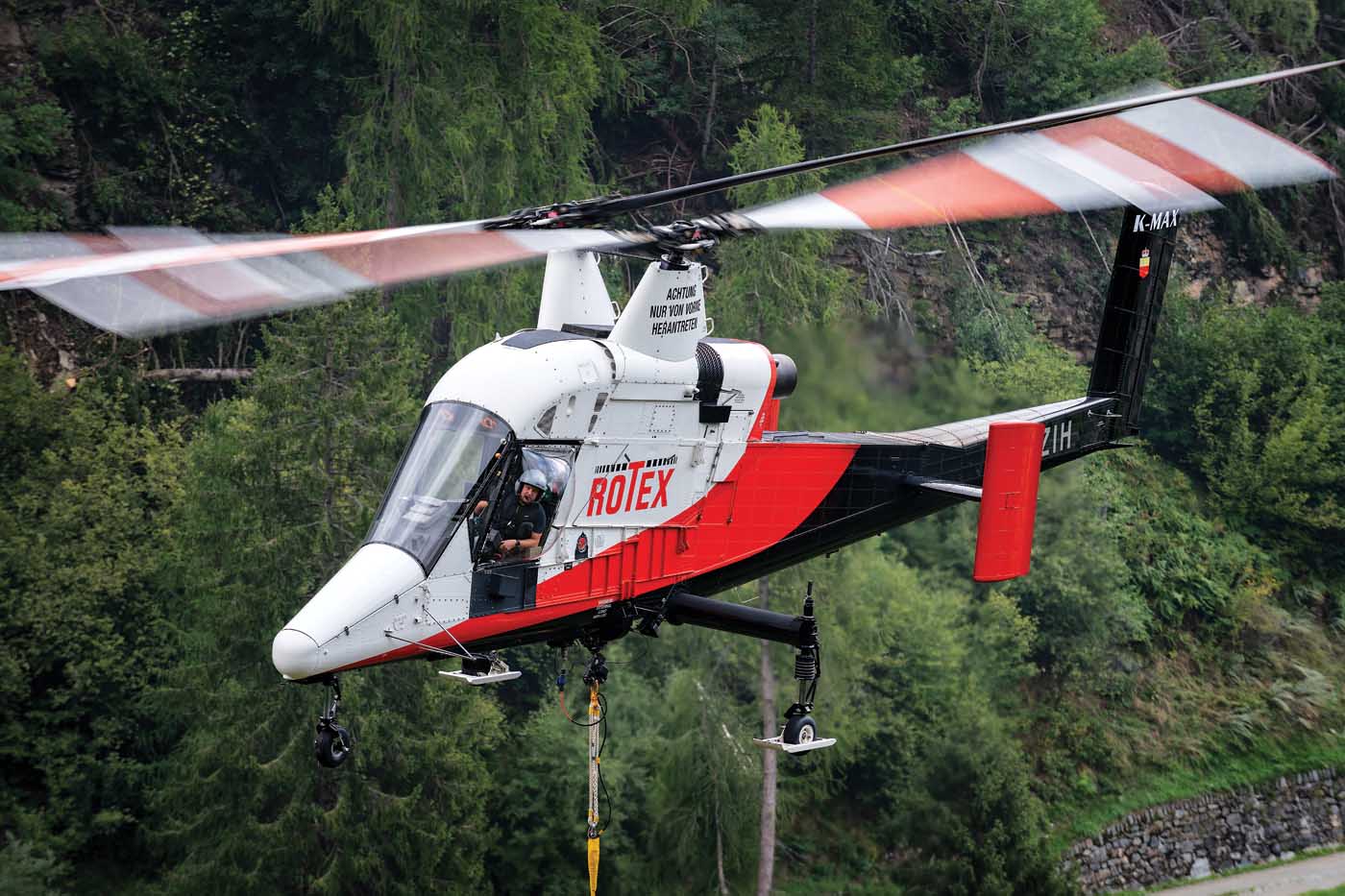Helicopters aren’t cheap, so it stands to reason that they must be as flexible as possible to be able to perform multiple roles. But there’s always an exception that proves the rule.

The exception in this case is Rotex Helicopters, whose operation exclusively in underslung loads (USL) has been a niche that it has made profitable since it opened for business in 1997. Headquartered in Liechtenstein (for operational, rather than tax reasons), the company works mostly in Switzerland, and has operated its aircraft all over Europe. But its focus early on was much closer to home.
“A couple of employees [from another operator] built their own company,” explained Renato Giezendanner, an Airbus H125 type-rated pilot and the project manager at Rotex. “They decided to focus on the timber market in Switzerland because they knew how to do it the right way.”
Timber logging is an important industry in Europe and the forested area of the continent is actually increasing. In Switzerland, forests not only have economic value, but also perform an important civic function; providing protection from avalanches for towns, villages, and roads. One third of the country is covered with woods and forests; and two thirds is mountainous. This makes helicopter logging an essential part of the industry.

“Rotex had one aircraft at the start,” said Giezendanner. “They did a lot with it. They averaged 1,800 flying hours per year, but only bought their second 10 years later.”
While logging was the company’s focus at its inception, Rotex has steadily expanded its portfolio, and its coverage, to incorporate underslung lifting of components for the construction and dismantling of large civil engineering projects, as well as firefighting. But it is in forestry that it maintains its core focus. For this, it has teams of specialist logging experts; a fleet of purpose-built “Helitrac” lifting vehicles to streamline the groundwork involved in organizing harvested timber for onward dispatch; and a hydraulic timber grabber — a log-lifting grappling claw that can exert a force of 2.3 tons. Controlled directly by the pilot, it enables logs to be lifted in remote sites unreachable by ground support parties.

The single aircraft per decade tempo that the company established was upheld with its third helicopter delivery in 2017.
All three aircraft are K-Max, Kaman’s synchropter that is so specifically designed for underslung load carriage that it has a crew of only one pilot and no internal cargo area. A pair of twin-blade rotors mounted on laterally outward-canted pylons above the fuselage are designed to intermesh perfectly. This arrangement was pioneered by German aero-engineer Anton Flettner, who arrived in the U.S. after the Second World War, courtesy of Operation Paperclip.
The setup maximizes the power available for lifting from the single Honeywell T53-17 engine, with none required for an anti-torque tail rotor. This means that the aircraft is tremendously powerful for its weight; at just 5,100 pounds ( 2,330 kilograms), it can lift over 6,000 pounds (2,720 kilograms) externally, and yet has a low downwash and noise footprint.
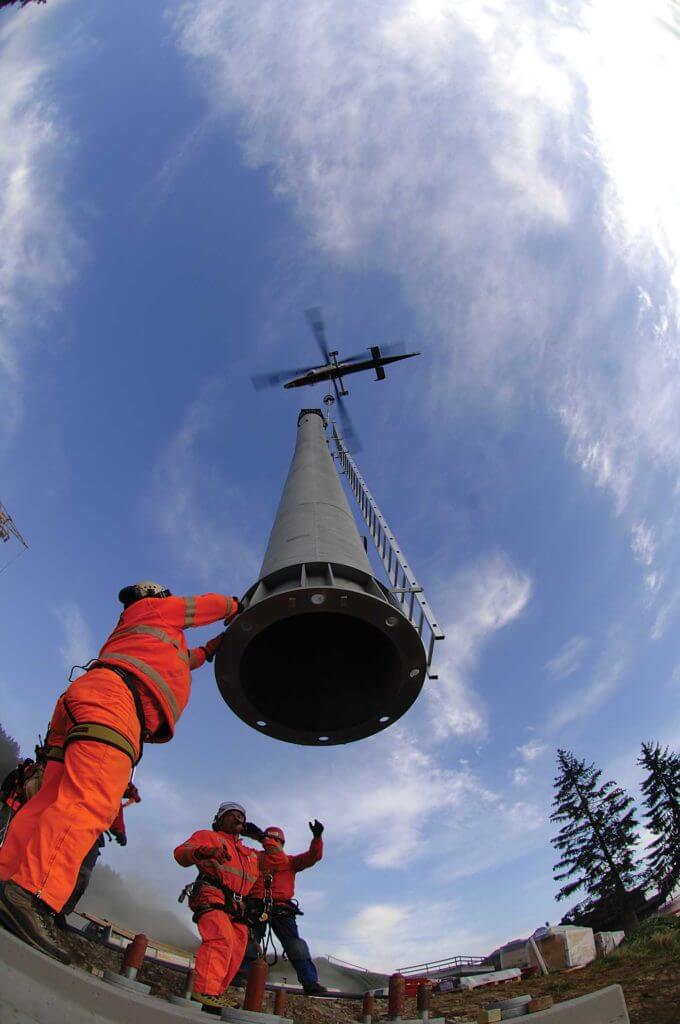
“It was an easy decision to procure the K-Max because there were plenty of other companies operating other aircraft in other business areas, but our niche perfectly suited operation of this aircraft,” said Urs Riebli, the CEO and one of the original company founders.
Not satisfied with the unusual intermeshing rotor design, Kaman designed the K-Max with another Flettner innovation; servo tab controls on the main rotors. This reduces control loads without complex and heavy hydraulic systems.
Production of the K-Max ended in 2003, but was restarted in 2017 after an unmanned version was produced in cooperation with Lockheed Martin for service with the U.S. Marine Corps in Afghanistan.

The right tool for the job
Rotex pilot Andi Redolfi explained that the aircraft was a perfect fit for the company’s work.
“We operate at over 6,000 feet above sea level and we want to have the maximum weight [in the load],” he said.
Formerly a helicopter mechanic, Redolfi trained to fly helicopters in the United States before moving back to Austria and cutting his teeth in utility work.

“I flew pretty much everything you can do with a helicopter,” he said. “Instruction, HEMS [helicopter emergency medical services) and heli-skiing. But this is very different.”
Flying the K-Max had been Redolfi’s ambition for a long time. Rotex typically requires its pilots to have 2,000 hours and 10,000 sling-load cycles, preferably in the Alps. The company invests 1.5 to two years training their pilots, so the job opportunity was too good to miss for Redolfi. His type rating was conducted at Kaman Aerosystems in Connecticut, with initial familiarization for the synchropter design being carried out on the manufacturer’s HH-43 Huskie.
“The K-Max is a very different aircraft in a lot of ways, and it behaves in slightly different ways to other helicopters,” said Redolfi. “But it is perfectly suited for this job, the ‘V’ shape of the aircraft means that the pilot’s view is perfect. There’s no blind spot. It’s made to fly vertical reference.”
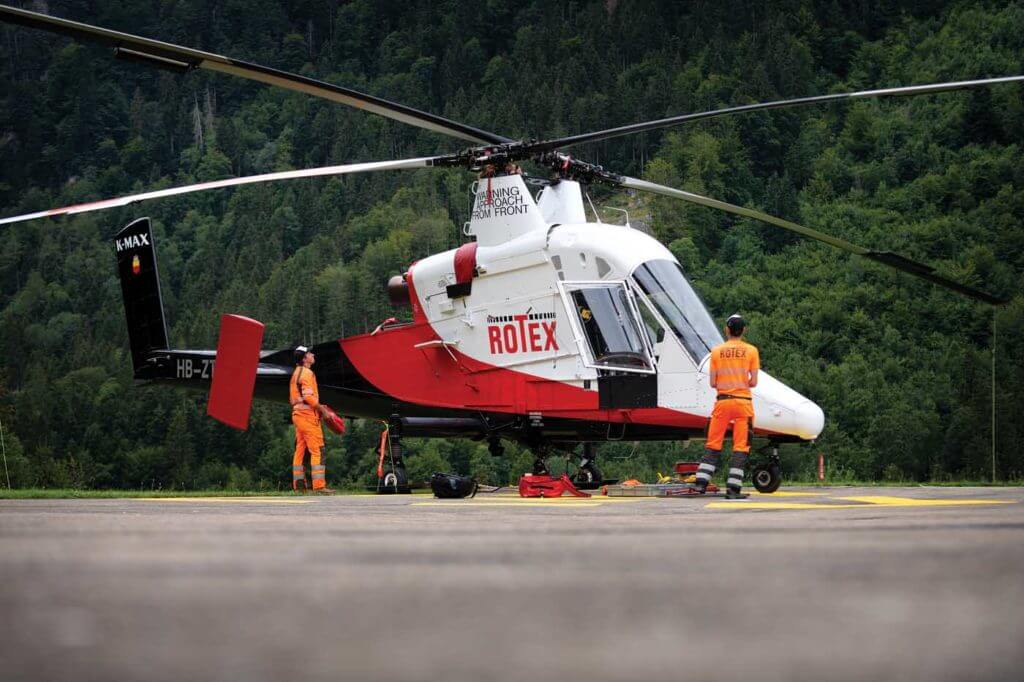
Flying sling loads in the Alpine regions of Europe, particularly when undertaking logging operations, is far from an individual effort on the part of the pilot. It’s a team sport, played on a field that sprawls across a mountainside and in which the competitors drive loaders, fly helicopters and climb trees in an effort to deliver 2.5-ton timber poles to their destination. Communication isn’t easy, and thorough planning and coordination is essential.
“The crews have to do everything by themselves, but the operation manager briefs everybody on the task, which actually means less work for the pilots than at other companies,” Redolfi explained. “The loadmasters have a tough job trying to get the load right to maximize the weight lifted, and of course the pilots have to check the weather and plan the flight thoroughly. But it’s got to be one of the best flying jobs in the world.”

Rewarding it might be, but it has its demands as well. “Because of the Flettner [servo tab] blade control, the K-Max doesn’t have hydraulics, so the controls are heavy,” said Redolfi. “The branches [of the logs] often get snagged so you have to be a little rough on the aircraft sometimes, you know. But the K-Max can handle it. It’s built for it.”
This is good news for the pilots, but you might expect this kind of behavior to have serious maintenance repercussions. On the contrary, explained Hans Fässler, “The aircraft is very efficient and does not require a lot of maintenance. If you get the schedule right, most of the maintenance can be done overnight.”
Fässler is the continuous airworthiness post-holder at Rotex, with overall responsibility for the aircraft maintenance schedule. He also holds a position with Swiss Helicopter Maintenance, which provide maintenance services for the K-Max. “100-hour inspections take a day, and 600-hourlies take two days to complete,” he said. “Everything up to 100-hour inspections is done in the field, the rest is done here at the headquarters.”
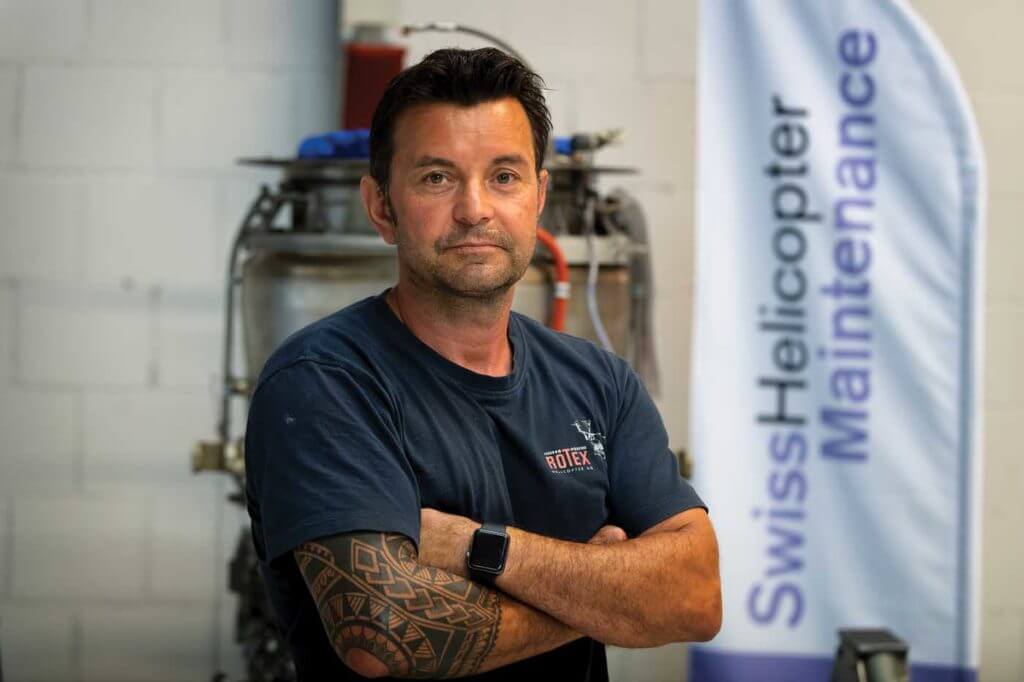
With such a well-integrated maintenance operation, aircraft availability is good, despite two of the aircraft having logged over 20,000 hours. But with such a unique aircraft, there is not a global abundance of spares. The rotor blades, with their esoteric design, are particularly difficult to get hold of. Rotex keeps a running stock of spare parts to avoid any need to wait and suffer long periods with aircraft on the ground (AOG).
“We have almost enough spare parts ourselves for another aircraft,” joked Renato Giezendanner. “Kaman are a good partner, but it is expensive for them to produce spares.”
There is no appetite in the company to look elsewhere, though. The pilots’ passion for the K-Max is shared by nearly everyone, including those responsible for ensuring the aircraft are profitable.
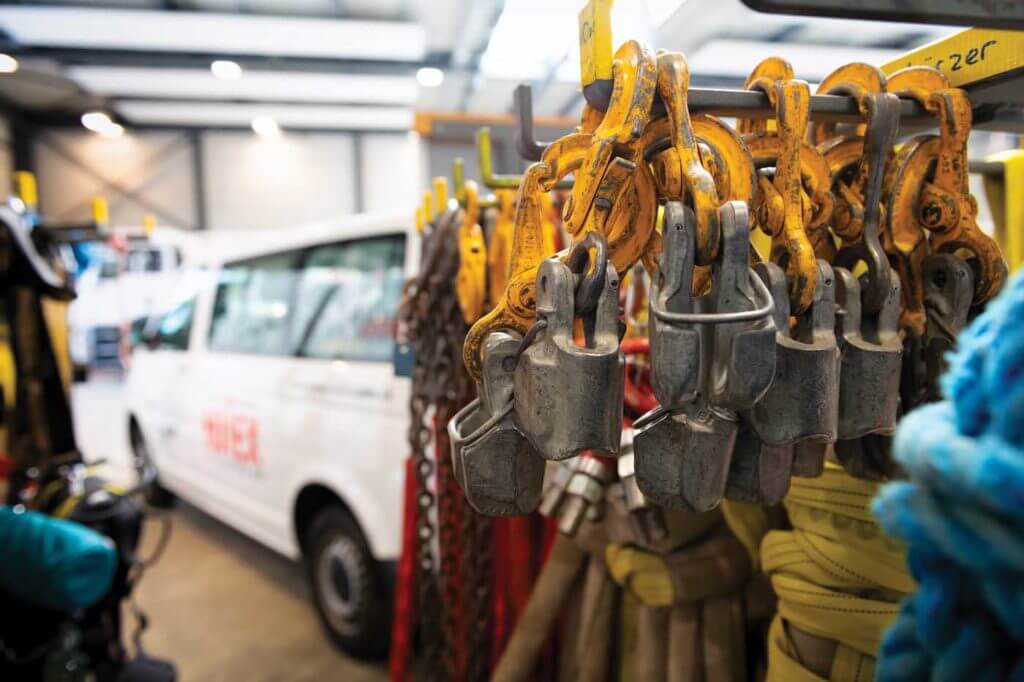
“In 2004 we did a lot of research into other helicopters but in this operation and this market the only competitive aircraft is the K-Max,” explained Urs Riebli.
Future plans
While Rotex remains committed to the K-Max, it has embarked on a modernization program.
Conventional gauges are becoming more expensive to replace, and the company wanted to provide modern capabilities such as terrain and obstacle warning. A modernized cockpit incorporating Garmin G500H Txi primary flight displays and multi-function flight displays, alongside a raft of other glass cockpit instruments, is being submitted to the European Aviation Safety Agency (EASA) for approval.

“When you have one type of aircraft you can focus on that type and put all your effort into support that machine,” said Riebli. “It is possible to be very clear in everybody’s mind that they will be working with K-Max and that’s it, otherwise you risk losing focus.”
This approach allows the company to customize its equipment, training and capability solely to support their current type and scale of operation, and Riebli doesn’t predict much change to this focus in the future.
“At the moment we have no plans for further aircraft, but we wish to invest in those helicopters and our capability,” he said. “It is risky to grow too fast, but we need incremental growth to support stability. We would like to do more with the aircraft and develop additional markets for work between the main timber seasons. With the efficiency of the K-Max and the experience of our crew, Rotex is ideally suited to build power lines or help fight forest fires.”

The aircraft are certainly not resting on their laurels, but there is undoubtedly potential for additional work in the quieter months. Firefighting in particular is area in which the company hopes to grow, and it has proven the potential of the K-Max in this role. It can lift a 2,500-liter (560-US gallon) SEI Industries Bambi Bucket, and Rotex has already fulfilled several contracts using this. However, there are few long-term firefighting contracts in Europe, and they are not easy to secure. Moreover, the capability to fly passengers is widely seen as essential.
Convincing those accustomed to more conventional helicopters is likely to be a long road, but Rotex doesn’t appear to be in a hurry. What modest growth objectives it has are based purely around greater utilization of its existing fleet, rather than expansion.
There is a complete focus about Rotex that is demonstrated in almost every facet not only of the company itself, but in those who support and serve it. Its pilots fly only sling-load operations in an aircraft designed exclusively for that role, built by a manufacturer that offers only that single type for civilian sale. While it is capable of wider utility, the majority of Rotex’s effort is centered around logging, with fleets of ground vehicles and specially trained support personnel.

Rotex would, of course, be threatened by any new entrant into its market. Its position makes this unlikely, but not for the obvious reason. The K-Max, although unique, is not the company’s selling point. While expensive, the aircraft is affordable if the flight hours are guaranteed – and the work is clearly there.
But in order to reach those flight hours, a newcomer would need 15 to 20 highly trained specialists on the ground to support each helicopter during operation. Pilots with the necessary skill are not plentiful, and the family ethos in Rotex would make it difficult for a new company to poach that talent. The experience of the maintenance crews to fine-tune the aircraft to make them more efficient and reliable is itself priceless.
Without this human tapestry of complex skills and experience, a newcomer would quickly founder, even before they tried to pry clients away from a company with Rotex’s enviable reputation. Little wonder then, that their mantra appears to be assured stability rather than rapid growth.
Very often it is the flexibility and broad range of capabilities of a helicopter type that allow profitability. In the case of the K-Max it is the opposite; total specialization.





